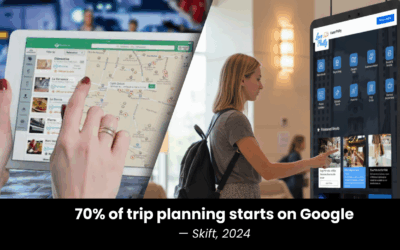As we move into the future, technology will continue to play a large role in our lives.
This is especially true when it comes to smart cities.
Smart cities are using digital trends to improve the quality of life for their citizens. In this blog post, we will discuss some of the most important digital trends that are impacting smart cities.
One of these trends is a cloud-based software for interactive kiosks.
Trend #1 – Digital Signage and Wayfinding
If you’re in the hospitality industry, then Digital Signage is a must for your destination.
Digital Signage can help reduce costs associated with paper printouts, and it can also help your area become more eco-friendly.
Digital Signage can also help increase guest satisfaction by providing clear and concise information about your area’s services and amenities. Other ways it can help your DMO are:
- Keeping people up-to-date with the weather
- Emergency services
- Using QR codes to help sell special items or promotions
In addition, Digital Signage can help you promote special events and promotions to your tourists.
If you’re looking for a way to improve your area’s bottom line, then Digital Signage is a trend you should definitely be on top of.
Trend #2 – Cloud-Based Software for Interactive Kiosks
As the world increasingly becomes digitized, we can expect to see more and more smart city technologies popping up in urban areas.
One trend that is already starting to take off is the use of cloud-based software for interactive kiosks.
By using a cloud-based platform, kiosks can provide up-to-date information on city events, attractions, and services. Some things you should look out for when choosing software are:
- Ease of use – It should be easy to use so that everyone can access it.
- Flexibility – The software should be flexible so that it can be used for a variety of purposes.
- Security – It should be secure so that your data is protected.
- Scalability – Is it scalable so that it can grow with your needs?
- Interoperability – Is the software compatible with other systems?
Additionally, they can be used to collect data from users, which can help city planners to make informed decisions about urban development.
As more and more cities embrace digital technologies, we can expect to see a wide range of innovative applications for smart city technologies.
Trend #3 – Sustainability
As the world becomes more aware of the importance of sustainability, we are seeing a trend of smart cities paying closer attention to this issue.
Part of being sustainable means that people are paying closer attention to the environment and how we can create a space that is accessible to everyone.
This includes things like using renewable energy sources, reducing pollution, and creating more efficient transportation systems.
Additionally, smart cities are also working on making themselves more resilient to climate change. This means that they are preparing for natural disasters and other events that could disrupt the city’s infrastructure.
By paying attention to these trends, smart cities can create a better future for all of their citizens.
As you can see, there are many digital trends that are impacting smart cities.
By keeping up with these trends, cities can improve the quality of life for their citizens and create a more sustainable future.
Trend #4 – Improved Connectivity
One of the most important trends for smart cities is improved connectivity.
As more and more devices are connected to the internet, it’s important for cities to have a strong and reliable network.
This way, they can take advantage of all the benefits that come with having a connected city.
Some of the benefits of improved connectivity include:
- Efficient city operations – When everything is connected,city operations can be more efficient. For example, if there’s a traffic jam, the city can reroute traffic to avoid it.
- Improved public safety – With a connected city, emergency services can respond more quickly to incidents.
- Better customer service – When city employees are connected, they can provide better customer service to citizens.
By improving connectivity, cities can make life easier for their citizens and run more efficiently.
Trend #5 – Big Data Analytics
Smart cities are generating a lot of data.
This data can be used to improve city operations and make informed decisions about urban development.
That’s where big data analytics comes in.
Big data analytics is the process of collecting, analyzing, and making decisions based on large sets of data.
This data can come from a variety of sources.
By using big data analytics, cities can improve their operations in a number of ways, such as:
- Identifying problems – Big data can be used to identify problems so that they can be fixed more quickly.
- Predicting trends – Predict future trends so that cities can plan for them.
- Improving customer service – It can be used to improve customer service by identifying areas where there is a need for improvement.
By using big data analytics, smart cities can become even more efficient and responsive to the needs of their citizens.
HootBoard Can Help with your Smart City Initiatives
HootBoard is a cloud-based software company that provides interactive kiosks and wayfinding solutions for smart cities.
Our products can help cities with a number of their initiatives, such as sustainability, improved connectivity, and big data analytics.
If you’re interested in learning more about how we can help schedule a free consultation today.
Smart City Trends and The Future
As you can see, there are many digital trends that are impacting smart cities. By keeping up with these trends, cities can improve the quality of life for their citizens and create a more sustainable future.




